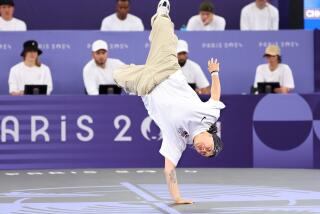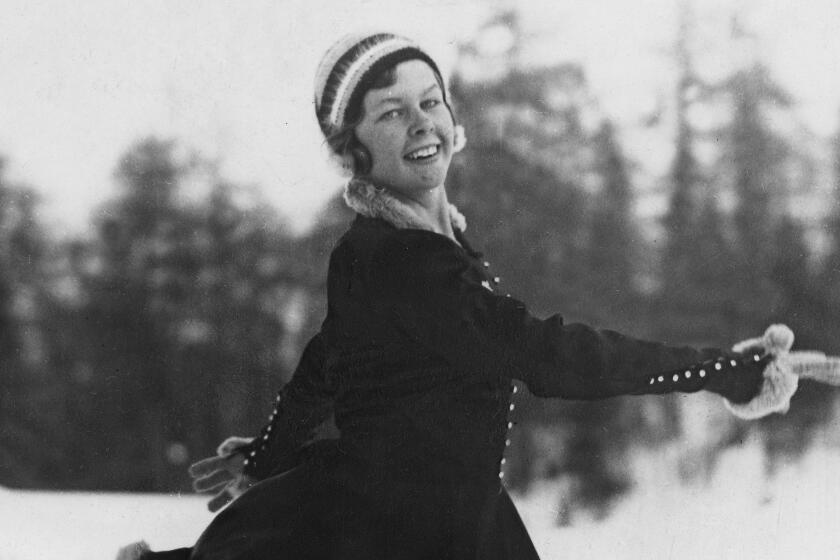Jones Is Only Hurting Herself : Hurdles winner Devers, cancer fighter Engquist and legally blind Runyan show how to meet adversity head-on.
SEVILLE, Spain — Primo Nebiolo, the de facto president for life of the International Amateur Athletic Federation, set a good example last week for track and field athletes in overcoming adversity.
Everybody talked about the heat in Seville for the World Championships, but only Nebiolo did something about it. He persuaded the mayor to turn off the digital temperature signs downtown, figuring that what the athletes didn’t know wouldn’t hurt them.
Gail Devers already knew something about adversity. She faced so much of it in the early ‘90s with Graves’ disease, a life-threatening thyroid condition, she became the subject of a made-for-television movie after winning the 100 meters in the 1992 Summer Olympics.
That was the first of her five major titles in the 100 and 100-meter hurdles over a four-year period. But injuries cut her seasons short in 1997 and ’98 and there were doubts about whether she would compete seriously again internationally.
Devers, 32, competed seriously Saturday night at Estadio Olimpico. She won her third world championship in the high hurdles with an American record of 12.37 seconds, easily besting Nigerian Glory Alozie’s 12.44.
As ecstatic as she was on crossing the finish line, Devers didn’t celebrate until she had paused to discover how Ludmila Engquist had finished. Learning from the scoreboard that Engquist had won the bronze medal in 12.47, Devers went to congratulate her but turned to find the Swede already at her side. They embraced.
If Devers is fortunate, the worst of her horror is behind her. Engquist, 35, returns home to face the fifth of seven chemotherapy sessions Thursday for breast cancer that was diagnosed in March. She had her right breast removed in April.
“I’m so proud of Ludmila, to come back and accomplish what she did,” Devers said. “It just shows that if you believe in yourself, dreams do come true.”
*
Then there is Marla Runyan.
She ran her semifinal Friday night in the women’s 1,500 in a personal best of 4 minutes 5.27 seconds and advanced to today’s final, which is an achievement considering this is her first World Championships. It is an astounding achievement considering that she is legally blind.
A victim of macular degeneration, she began losing her sight when she was 9. Today, she has 20-800 vision, which, with contact lenses, can be improved to 20-300. She can see well peripherally, or when she looks at the ground, but hardly at all when looking ahead.
That causes her problems when training in the streets of her hometown, Eugene, Ore., where she has been known to run into parking meters, but not so many on the track.
“I know where the finish line is,” she said. “It’s always at the end of the straightaway.”
She found it before anyone else did in this summer’s Pan American Games.
“I guess I’m used to my eyesight being the way it is,” she said. “I learned to run track as a legally blind person. I don’t know any different, and I don’t know how everyone else sees it. I just know what it’s like for me.”
*
Maybe Marion Jones will learn from those three women.
She arrived here with almost as much fanfare as Christopher Columbus did after his third voyage to the New World but left under a veil of silence Saturday morning.
Where did she go? Some said to Barcelona, to await doctor’s orders on whether she can resume competing on the European circuit. Some said to her home in Raleigh, N.C., to see her personal physician and maybe to batten the hatches in advance of Hurricane Dennis.
What was her condition? The word seeping out of her camp was that she was still experiencing back spasms, which literally stopped her in her tracks in the 200-meter semifinals Wednesday night.
But neither she nor the doctors who attended her gave interviews, creating an information vacuum that was filled with rumors of a more serious injury.
They are probably false, but going to the USA Track & Field office inside Estadio Olimpico in search of the truth was a waste of steps. The American officials were as far out of the loop as the media and decidedly more embarrassed about it. We are used to having to seek out information about their athletes. They are not.
Finally, at about 6:30 p.m. Saturday, USATF released a vague statement on behalf of Jones’ agent, revealing Jones had flown home and will be examined by her doctor before deciding about the rest of the season.
Why all the mystery?
The track and field female athlete of the year in 1997 and ‘98, Jones, 23, has created more interest than any other competitor in the sport with her marvelous talent and ambitious goals.
But, at the first hint of adversity, she constructed a wall around herself. Or maybe it was her coach or manager or husband who did it. Whatever, it is as thick as the one that once stood in Berlin.
My sense of her is that this is, well, not her. She is bright and charming and, once the shock of the injury wears off, she’ll recognize, like Carl Lewis did after the L.A. Olympics in 1984, that it’s best for her sport--and her too--if she is more open.
More problematic could be the injury, the first of her career that has caused her to miss significant competition.
She did not respond well to a minor tweak of her knee earlier this summer while long jumping. She spoke here before the calamity about her fear of a recurrence and altered her landing, which might have contributed to the back injury.
How she reacts to this one could determine whether she has the mental and physical wherewithal to pursue her goal of five gold medals next summer in Sydney. We’ll find out within the next 12 months whether she can stand the heat.
Randy Harvey can be reached at his e-mail address: randy.harvey@latimes.com
More to Read
Go beyond the scoreboard
Get the latest on L.A.'s teams in the daily Sports Report newsletter.
You may occasionally receive promotional content from the Los Angeles Times.







